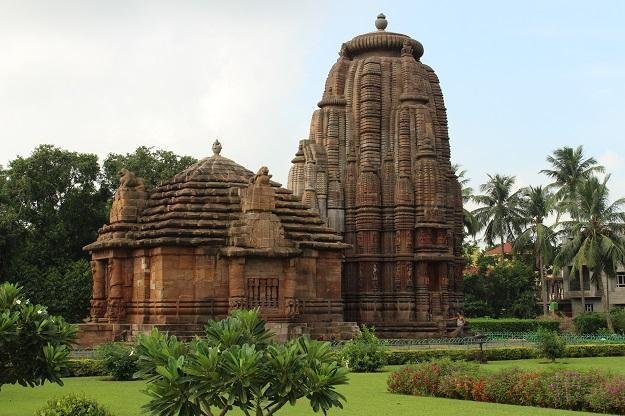Contents
Rajarani Temple, Bhubaneswar, Odisha
| Date built: | 11th-century |
|---|---|
| Deity: | – |
| Architectural style: | Kalingan Pancharatha Style |
| Major festivals | – |
| Locale: | – |
| District:: | Bhubaneswar |
| Address: | Tankapani Rd, Near BOI ATM, Bhubaneswar, Odisha 751002 |
| Phone | – |
Rajarani Temple is an 11th-century Hindu temple located in Bhubaneswar, the capital city of Odisha (Orissa previously), India. The temple is believed to have been known originally as Indreswara. It is locally known as a “love temple” because of the erotic carvings of women and couples in the temple. Rajarani Temple is built in the pancharatha style on a raised platform with two structures: a central shrine called the vimana (sanctum) with a bada (curvilinear spire) over its roof rising to a height of 18 m (59 ft), and a viewing hall called jagamohana with a pyramidal roof. The temple was constructed of dull red and yellow sandstone locally called “Rajarani”. There are no images inside the sanctum, and hence it is not associated with a specific sect of Hinduism but broadly classified as Saivite based on the niches.
Various historians place the original construction date between the 11th and 12th centuries, and have placed it roughly belonging to the same period as the Jagannath Temple at Puri. The architecture of other temples in central India is believed to have originated with this temple, the notable ones being the Khajuraho temples and Totesvara Mahadeo temple in Kadawa.There are various sculptures in the walls around the temple, and the vimana depicting scenes of the marriage of Shiva, Nataraja, Parvati, and include tall, slender, sophisticated nayikas in various roles and moods such as turning her head from an emaciated ascetic, fondling her child, holding a branch of tree, attending to her toilet, looking into a mirror, taking off her anklet, caressing her pet bird and playing a musical instrument. Rajarani Temple is maintained by the Archaeological Survey of India (ASI) as a ticketed (pay to enter) monument.
Architecture
The Orissan temples have two parts namely the sanctum (deul or vimana) and the other is place from where pilgrims view the sanctum (called jagamohana). The initial deul temples were without the jagamohana as seen in some of the older temples in Bhubaneswar while the later temples had two additional structures namely nata-mandapa (festival hall) and bhoga-mandapa (hall of offerings). The vimana is square in plan, and the walls are variegated by ressaults (called rathas or pagas).Amalaka (also called mastaka), a stone disk with ridges on the rim, is placed over the bada (tower) of the temple. Rajarani Temple stands on a raised platform. The temple was constructed of dull red and yellow sandstone locally called “Rajarani”.
Vimana
It is pancharatha in plan with a curvilinear superstructure (rekha shikhara) 18m(55 ft) tall. The vimana (tower) is surrounded by a cluster of miniature towers with double crowning elements and appears round, unlike other temples in Bhubaneswar but like the towers of Khajuraho temples. The temple stands on a plinth with three mouldings. The bada consists of five divisions instead of the three divisions usually found in other temples. The vimanarises to a height of 17.98 metres (59.0 ft) from the basement.The vimana (sanctum) measures 10.25 ft (3.12 m)*10.25 ft (3.12 m) from the inside, 31 ft (9.4 m)*29 ft (8.8 m) from the outside.[10] Its spire is decorated with clusters of turrets (replication of the spire itself) emerging from the rib of the spire. The temple has panchanga bada, or five divisions, namely, pabhaga, talajangha, bandhana, uparajangha and baranda. The lowermost division, called the pabhaga, has five decorative mouldings, namely, khura, kumbha, patta, kani and basanta. The superstructure (gandi) of the temple has a number of miniature turrets (angashikharas). The superstructure is crowned with a fluted disc-shaped architectural piece called an amalaka, and a vase (kalasa) surmounts it as the crowning finial.
Jagamohana
Sculptures
The sculptures have a depth that was lacking in the Mukteswara Temple sculptures.[11] The slightly projecting entrance is flanked by round thick columns entwined by naga on the left. Guardians of the eight directions project from the base of the temple in the eight directions, starting from the gateway in a clockwise direction around the porch and the deul, ending at the torana (entrance).[11] The other noted sculptures are naga-nagi sthambha, saiva dwarapalas on the entrance doorjambs, and lakulisa on the lintel of entrance, above which is the architrave of Navagrahas.[clarification needed] The best-preserved sculptures of the temple are the standing astadikpalas on the central façade of kanika, appearing on the jangha portion of the bada clad in diaphanous drapery. The image of Varuna is intact and notable for its body ornamentation, coiffure and facial expression. Scenes of the marriage of Shiva, Nataraja, and Parvati are the cult images present in the temple. There are tall, slender, sophisticated nayikas gracing the walls of the sanctum depicted in various roles and moods in amorous dalliance with actions such as turning her head from an emaciated ascetic, fondling her child, holding a branch of tree, attending to her toilet, looking into mirror, taking off her anklet, caressing her pet bird and playing instrument. There are also erotic (mithuna) figures carved in high relief on the projecting portions of the uparajangha. The other decorative motifs are carved in the shape of vyala, jagrata and gajakranta. The scroll motifs are of foliage, creepers and vines (vanalata), each containing lush foliage independent of any stalk or vine.
Legend / Local stories
Based on the sculptural architectural style, the temple is dated to the mid-11th century.Brown groups the temple along with Anant Vasudev Temple and places it around the 11th–12th centuries. Another survey of Orissa temples carried out by S. K. Saraswati in 1953 yielded a similar date. Panigrahi, who did a comprehensive analysis of Orissan temples, gives an unspecified date between Lingaraj Temple and Mukteswara Temple.Fergusson believes construction of the temple was begun by around 1105.George Michell believes the temple was built during the same time as Lingaraja Temple.Rajarani Temple roughly belongs to the same period as the Jagannath Templeat Puri. The architecture of other temples in central India originated from this temple. The notable ones in the category are the Khajuraho temples and Totesvara Mahadeo temple in Kadawa. Scholars believe based on the style that the temple might have been built by Somavamsi kings who migrated from Central Indis to Orissa during the period. Rajarani temple is maintained by the Archaeological Survey of India (ASI) as a ticketed monument.
Photo Gallery
How to Reach:
Contact Details
Official Address


